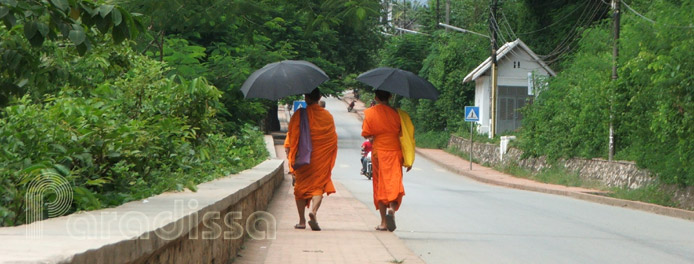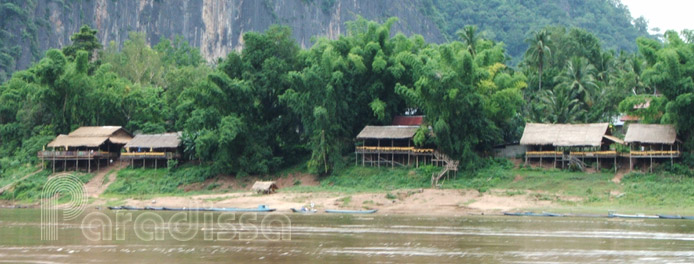Most parts of Laos, Cambodia and Thailand were inhabited as early as 10,000 years ago. Many of the ethnic groups in this area belonged to the Austro-Asiatic ethno-linguistic family.
From around the 8th century and especially from the 10th century, there were significant numbers of Austro-Thai in southern China and northern Vietnam migrating southward and westward. They established their polities and called these Muangs which were ruled by a chieftain. The Austro-Thai tended to base their Muangs in river valleys. In the mid of the 13th century, there were more dramatic migrations of the Austro-Thai into what is now Laos, Myanmar, Thailand and Cambodia due to the rise of Kublai Khan in China. Meanwhile in southern Laos, from Champasak to north western Cambodia, it was the Mon-Khmer Funan kingdom (1st-6th centuries AD) and Chenla kingdom (6th-8th centuries AD). In the north of Laos, there were 2 Mon kingdoms called Sri Gotapura (present day Tha Khaek) and Muang Sawa (Luang Phabang) from the 8th to the 12th centuries.
In the mid 13th century, a Tai rebellion against the Khmers rule resulted in the birth of Sukhothai kingdom in northern Thailand. With the help of Sukhothai’s king, Lanna kingdom was founded. Lanna extended across north-central Thailand and Muang Sawa (Luang Phabang) and Wieng Chan (Vientiane). It’s still controversial nowadays whether Lanna was Lao or Thai.
In the 14th century, Lanna declined, a Lao warlord named Chao Fa Ngum took Wieng Chan with the Khmers’ support. With the declining Khmer empire, Fa Ngum gradually managed to conquest Wieng Chan, Phuan (Xieng Khuang), the Khorat Plateau (north-eastern Thailand) and Muang Sawa (Luang Phabang). Fa Ngum declared himself king of these territories and called it Lang Xang (Million Elephants). Due to his autocracy, Fa Ngum was deposed by his own ministers in 1373. Fa Ngum’s eldest son, Oun Heuan-titled Samsenthai, succeeded his father and build Lan Xang into an important trade center. In 1421 Samsenthai died, Lan Xang lapsed into warring factions ruled by successive kings.
In 1520 King Phothisarat ascended the throne and moved the capital to Vieng Chan. In 1545 Phothisarat subdued Lanna and gained the throne of Lanna for his son, Setthathirat. In 1548 Setthahirat inherited Lan Xang kingship after his father’s death. In 1571 King Setthathirat disappeared when coming back after his invasion into Cambodia. Lan Xang declined rapidly without a leader, the kingdom was attacked constantly by the Burmese.
In 1637 King Suriya Vongsa ascended the throne after defeating other warlords. 57 years under King Suriya Vongsa reign, Laos experienced “The Golden Age” in terms of territory, prestige and power.
In 1694 Suriya Vongsa died without an heir, Lan Xang was broken up into 3 kingdoms: Suriya’s nephew took the area around Wieng Chan; the grandsons took the area around Luang Phabang; a prince took Champasak.
From 1763-1769 the Burmese annexed Luang Phabang. In 1778 the Siamese took Champasak, by the end of the 18th century the Siamese took Wieng Chan and exacted tribute from Luang Phabang. In 1820 Chao Anou a Lao prince who had been installed as the vassal king of Wieng Chan tried to assert his independence which led to the Siamese sacking of Wieng Chan, Champasak and Luang Phabang. By the late 19th century, most of the area between the Mekong River and the Truong Son Mountain had been under Siam’s control.
1893-1907 there were successive treaties between Siam and France which led to the relinquishment of the Siamese control of the territory east of the Mekong River retaining everything to the west. The French then united the remaining principalities as one colony and named it Laos.
During World War II (1939-1945) Japan stationed troops in Indochina under an agreement with the French, who maintained their administration throughout most of the war. In the last six months of the war the Japanese seized control of Indochina and interned French officials and troops. The Japanese granted Laos nominal independence in 1945.
After Japan and its allies lost the war, a nationalist movement known as the Lao Issara (Free Laos) formed an independent government in Laos. However, France reoccupied Laos the following year, and the nationalists fled to Thailand. The French unified their Lao territories into a single country with the king of Luang Phabang, Sisavang Vong, as head of state. Under French supervision, the new government adopted a constitution and joined the French Union.
In 1950 the Free Lao Front and the Laos Resistance Government under Prince Souphanouvong were founded in Eastern Laos to fight the French. Pathet Laos (PL: Land of the Laos) were the tactical forces of the Free Laos Front; in 1965 the name was changed to Lao People’s Liberation Army.
France accorded Laos full independence in 1953 as a constitutional monarchy, the Kingdom of Laos. Delegates to the 1954 Geneva Conference, who were negotiating France’s withdrawal from Indochina at the end of the First Indochina War (1946-1954), endorsed the country’s independent status.
In 1955 Laos People’s Party was founded. A national front was set up in 1956 called the Lao Patriotic Front (LPF).
In 1957 the Lao Patriotic Front and the Royal Laos Government agreed to a coalition government. Two LPF ministers and their deputies were admitted at the national level. In 1958 the National Assembly election gained unexpected supports for the LPF from the general populace in 2 north-eastern provinces, this led to the arrests of LPF ministers and deputies by the right-wing military. Within 1 year of their arrests, Prince Souphanouvong and LPF colleagues had escaped and were leading the resistance in the countryside.
In 1960 Kong Le leading his neutralist military seized Vientiane in a coup d’etat recalling Souvana Phouma from France to serve as prime minister. The rightist military led by General Phoumi Novasan withdrew to the South only to launch an attack on Vientiane and wrested control from the neutralist in a rigged election. Kong Le and his troops retreated to Xieng Khuang to join the PL.
In 1961 a 14-nation conference convened in Geneva. In 1962 agreements were signed proving for an independent, neutral Laos. A Government of National Union was again formed, a coalition of Prince Souvana Phouma (neutralist), Souphanouvong (PL) and Prince Boun Oum (rightist). Disputes over administration led to series of coup and counter coup in 1964 which resulted in the alignment of the PL on one side and the leftist and rightist military factions on the other.
During the Second Indochina War, Laos was heavily bombed. When the USA was negotiating its way out of Vietnam Laos was still divided into 2 zones: the PL controlled 11 out of 13 provinces. In 1975 the PL seized control of Pakse and Savannakhet and Vientiane. Lao People’s Revolutionary Party was declared the ruling party. Laos was named the Lao People’s Democratic Republic.
Laos today is a country of peace and abundant in natural resources. The Lao people are friendly and warm-hearted. Traveling in the country, you'll still find the vestiges of the conflicts in the history of Laos here and there. Paradissa offers a complete collection of tours in Laos from a relaxing vacation, a history and culture experience to an adventure of a life time through the wild of the Million Elephants Kingdom.












